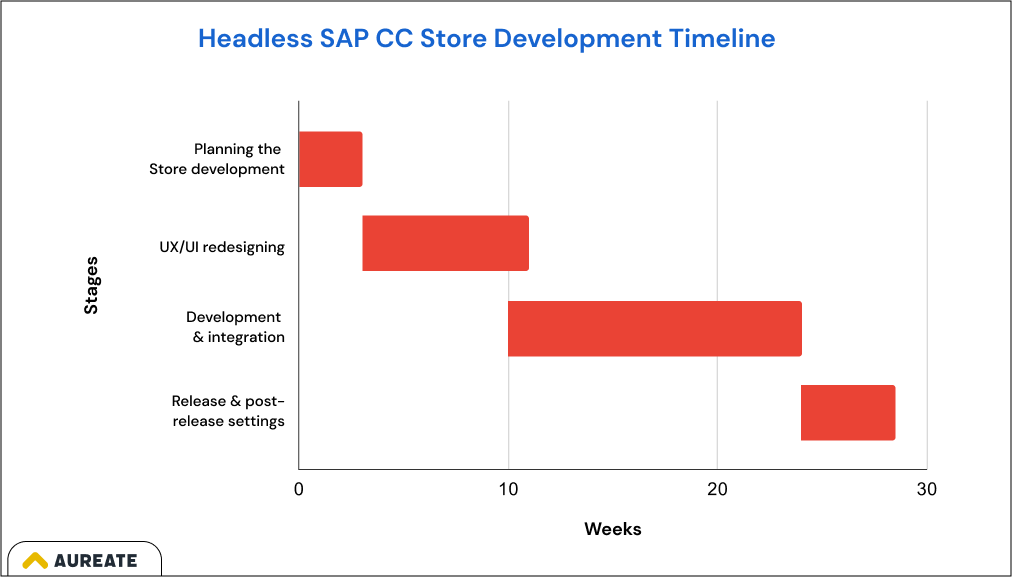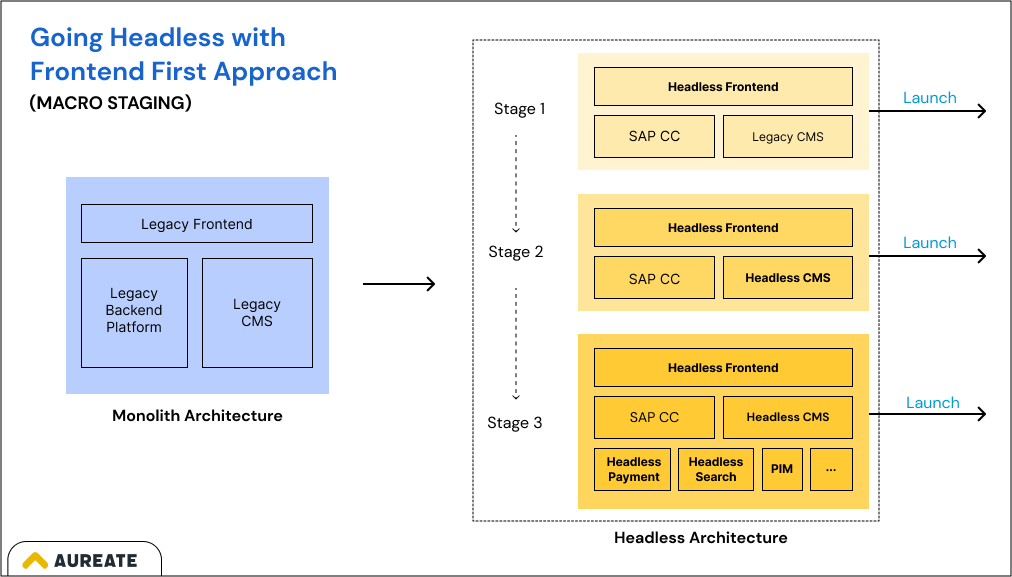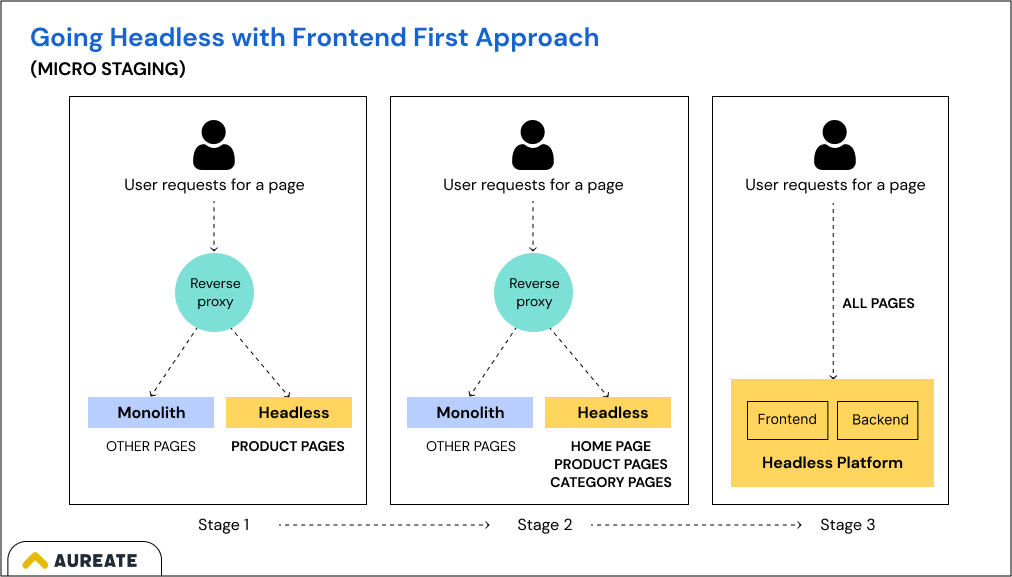Time and Cost to Build Headless SAP Commerce Cloud Store

In the digital commerce industry, “headless” has become a buzzword, promising freedom, flexibility, and omnichannel experiences. But for the merchants considering a headless approach for their existing eCommerce businesses, the reality is often unclear:
- What’s the true investment?
- How long until that sleek, customized storefront greets the world?
Want to go Headless with your existing SAP Commerce Cloud platform and have the same questions in mind??
Don’t worry! This blog sheds light on the time and cost of building your headless SAP Commerce Cloud store, armed with insights and data to guide your decision-making.
So, let’s get started!
Going Headless with SAP Commerce Cloud
Headless architecture decouples your storefront from the backend, empowering you to craft stunning, device-agnostic experiences – from smartwatches to AR mirrors. SAP Commerce Cloud, with its robust API, scalability, and proven B2B/B2C prowess, makes a compelling case for a headless pairing.
However, like any powerful tool, complexity lurks beneath the surface. Integration needs, development expertise, and potential challenges in managing the separate “heads” and “body” require careful consideration. But with the right planning and execution, these hurdles can be gracefully overcome.
And, the planning starts with the first and most important step: Understanding Your Needs 👇👇👇
Going headless means you must have a strong reason. When any client approaches us for Headless commerce solutions, the first question we ask is: What do they want to achieve with Headless??
Likewise, you should answer a few questions before you start your headless development.

1. What problems are you solving with Headless?
Identify the pain points your headless store will address. Do you want to personalize customer experiences, boost omnichannel engagement, or integrate additional systems? Clearly defined goals ensure your headless transition navigates towards true value.
2. Who is your target audience?
Are you targeting Gen Z mobile shoppers or B2B buyers accustomed to desktop interactions? Understanding their demographics, digital habits, and preferred devices is crucial for improving the customer experience (CX).
Develop detailed profiles of your key user segments, outlining their needs, goals, and pain points. This helps personalize content and functionality for each persona.
3. What functionalities are essential?

Prioritize essential functionalities like personalized product search, cart and checkout experience, payment processing, and order management. Remember, a streamlined headless approach often focuses on a robust frontend (with existing site features) and integrates additional functionalities later.
Also, consider your growth plans. Will you need B2B support, advanced personalization, or complex order fulfillment workflows in the future? List down all the required features you want to unlock with Headless Commerce.
4. What is your budget and deadline?
Factor in software licensing, development costs (in-house vs. agency), hosting and infrastructure, and ongoing maintenance. Research the pricing models of different headless tools and platforms to get a realistic budget estimate.
Discuss with your IT team and define an estimated timeline for your headless implementation, factoring in complexity, team size, and integration needs.
Pro tip: Consider an agile development approach for iterative progress and course correction.
5. Which frontend framework do you want to use?
Designed specifically for SAP Commerce Cloud, Spartacus ensures seamless integration and offers pre-built components for common functionalities.

But there are other popular frontends like Alokai (Formerly Vue Storefront) or Qwik Commerce each offering unique advantages. Explore every option and pick the one that suits your custom frontend objective. After all, this is what headless commerce is known for!
6. Will you need to partner with external agencies or developers?
If your team possesses the necessary skills in API integration, frontend development for your chosen framework, and potentially back-end systems, you might be able to handle the project internally.
However, if your team lacks specific skills, expertise in certain headless technologies, or sufficient bandwidth to handle the project efficiently, partnering with a reliable Headless development agency can be beneficial.
7. What existing systems will you integrate?
Headless thrives on seamless integration with other systems like CMS, PIM, marketing automation platforms, and payment gateways. Identify all necessary integrations and ensure compatibility with your chosen headless frontend framework and commerce engine, i.e. SAP commerce cloud.
8. What are your long-term plans for your headless platform?
Headless architecture offers incredible flexibility and agility, making it a future-proof choice for your e-commerce platform. But to truly unlock its potential, you need a vision for how it will evolve over time.
- Will you enter new markets or regions?
- Do you envision additional channels or touchpoints?
- Will you integrate AI or machine learning capabilities?
9. How will you measure success?
Go beyond just website traffic and focus on metrics that align with your business objectives. Set measurable KPIs (Key Performance Indicators) to track the effectiveness of your headless implementation. This could include conversion rate, average order value, customer lifetime value, or engagement metrics.
So, the question-answer round comes to an end here. Now we shall calculate the cost and time it takes to build a headless SAP commerce cloud store.
How Much Does Headless Commerce Cost for SAP CC Stores?
Building a headless store with SAP Commerce Cloud offers flexibility and omnichannel power, but at what cost?
Let’s break down the estimated headless development cost with realistic numbers below:
| Item | Estimated Cost |
| Frontend Licenses(per annum) | $0 – $30,000 |
| UI/UX Designing | $20,000 – $30,000 |
| Integration and Custom Development | $40,000 – $90,000 |
| Frontend Hosting (for 1M visits) | Approx. $2000 |
| TOTAL | $62,000 – $1,52,000 |
Please note that these are just estimated costs, and the actual cost of your headless commerce project may vary.
Let’s discuss all the possible costs in detail.
Frontend Licenses
You’ll need a JavaScript framework to build your Headless storefront.
Now, as you’ve SAP CC as your backend, you can use the Spartacus (SAP Composable storefront) frontend without spending a single penny.
But if you want to explore other frontend solutions, you can go with some popular options that include Alokai (Formerly Vue Storefront), Qwik Commerce, other JS frameworks, etc. Some of these frameworks have open-source versions with paid enterprise editions for advanced features and support.
Open-source versions are usually free, while enterprise editions can range from $10,000 to $30,000 per year.
UI/UX Designing

Creating a user-centric and visually appealing headless storefront requires expert UI/UX design. Expect to spend $20,000 to $30,000 on design services, depending on the complexity of your store and the desired level of customization.
Integration and Custom Development
Connecting your headless storefront to your SAP Commerce Cloud backend and any other necessary systems (e.g., PIM, CMS) can increase costs depending on the complexity and number of APIs involved. The cost can vary significantly depending on the complexity of the integrations, starting from $40,000.
If your business requires specific functionality not readily available through existing APIs, expect to pay for custom development. The cost will depend on the specific features you need but can range from $5,000 to $60,000.
Hosting and Infrastructure
You’ll need to host your headless storefront in the cloud. The cost will depend on your traffic volume and required resources. Expect to pay approx. $2,000 (per 1 Million visits) for frontend hosting, with the potential to scale up for larger stores.
Apart from these major costs, you should also consider the additional cost of
- third-party tools (search, checkout, payment, etc.)
- ongoing maintenance of your headless store
- regular performance optimization
- enabling touch points (kiosks, voice assistants, etc.)
I haven’t added the additional costs in the table above because these are avoidable costs. After all as a business owner, you’ll only decide whether to pick those additional features and services or not.
On the same note, let’s move ahead to know the estimated development time for the headless store.
How Much Time Does it Take to build SAP Commerce Cloud Headless store?
Now, let’s talk timeframes. A typical headless implementation with SAP Commerce Cloud might take 4 – 7 months, depending on complexity, team experience, and integration scope.
Here’s the breakdown of the time duration it may take to build a SAP CC headless store:
| No. | Stage | Duration |
| 1 | Planning the store development | 2 – 4 Weeks |
| 2 | UX/UI redesigning | 4 – 12 Weeks |
| 3 | Development, and integration | 12 – 16 Weeks |
| 4 | Release and post-release settings | 3 – 6 Weeks |
| Total | 21 – 38 Weeks |
So, this is the estimated time of developing your headless store. But you can cut down the total duration (to 4 – 7 months) by performing the different tasks in parallel. This is what Headless is known for.
Couldn’t understand?? Here you go!
Headless architecture allows different aspects of the store, like the front-end design, and back-end, to be developed simultaneously by different teams or experts.

By working on different parts of the store in parallel, the overall development time can be significantly shortened. This is a key advantage of headless, which you won’t get in the existing monolith architecture.
Thanks to our innovative headless approach, we achieved an incredible 8-week turnaround for a recent client’s headless SAP CC store – that’s 6x faster than the industry average!
Talk to our Headless experts now!
So far we’ve learned about the cost and time to build SAP Commerce Cloud Headless store. Now, some of you may find headless commerce a heavy investment in terms of cost and time it takes. Yes, it is a huge investment!!
But, guess what?? Every problem has a solution. And we also have a solution for this situation.
I want you to pay attention to the next section.
Possible to Go Headless on a Shoestring?
Wondering whether you can go headless with a tight budget??
Well, as a Headless eCommerce development company, we receive such questions every day. Many brands want to accept the headless transformation but when they come to this stage, they give it a second thought.
Nothing to worry about, as we have a solution: Frontend First Approach!!
So, in the Frontend First approach, you can achieve Headless architecture step by step. This can be done in two ways:
- Macro Staging Headless
- Micro Staging Headless
This is what we named it. Let’s understand both one by one!
1. Macro Staging Headless

As you can see in the picture above, the headless transition is done in multiple stages (Stage 1, 2, and 3).
In this method, you start with integrating the Headless frontend first (like in Stage 1). Then you can connect other Headless components (such as CMS, search, PIM, checkout, payment, etc.) gradually in your platform at a certain interval.
It will take comparatively less time and cost than building the complete Headless solution at once (like in Stage 2, and Stage 3).
2. Micro Staging Headless
This method goes beyond macro staging. Here, you can start the Headless transition in chunks (page by page).
Let’s understand this using graphics.

The image shows the headless transition (Stage 1) by migrating the product pages at first.
It means that instead of migrating the entire website to Headless architecture, only a few pages (that will benefit from Headless the most) are transformed.
Here the “Reverse proxy” acts as a request manager that gives appropriate directions to the user requests.
Now what happens is when the user requests a product page, “Reverse proxy” will redirect it to the Headless platform. And, requests for other pages will be redirected to the Monolith platform.
You might be wondering if this is just the Stage 1 headless transition, and then how the other stages will work. Here’s the answer!

Can you see the difference between the stages??? Here, the Stage 1 & 2 are partial Headless transitions. And ofcourse, Stage 3 represents the complete transition.
By developing your Headless SAP CC store in stages (i.e., agile development), you can
- avoid the heavy investment at the initial stage
- go-to-market early with your Headless store
- deep acceleration from the beginning
- realize the ROI faster
On the other hand, you can also test the headless approach before complete implementation and save upto 60% investment if you don’t see any results after the headless transition. This means there will be less risk in terms of costs and delivery timeline.
Now, we’ll head towards ROI calculation and check whether this big investment is worth it or not.
What is the ROI Equation of Headless Investment?

Every investment is measured by the ROI. While there is an initial investment required to implement a headless SAP CC store, the long-term returns can be significant.
Measuring Headless ROI only with conversion can be UNFAIR as there are many aspects or reasons for choosing the Headless architecture.
Do you remember those pain points that made you think of this huge transformation?? It could be the complex customization, limited out-of-the-box features, or scalability issues… as an eCommerce merchant, you know this well.
So, let’s open our sights wider and see other aspects of returns we can gain with Headless commerce.
Here are some of the ways headless SAP CC stores can deliver a positive ROI:
- Reduction in operation time and costs (with monolith architecture).
- Faster Go-to-Market (GTM) with custom functionalities.
- Increased flexibility to adapt to changing trends.
- Seamless omnichannel experience.
- Future-proofing your eCommerce business.
Case study 1: One of our clients was seeking an omnichannel solution and after implementing a headless, their management time and operation costs were reduced drastically. Also, they saw a 5% increase in conversion rates which resulted in a substantial boost in revenue and a rapid payback on their investment within just six months.
Case study 2: Another client wanted to implement “advanced search and product discovery” in their online store. Due to the headless architecture, they were able to test all the selected tools quickly and pick the right one for their platform.
This way they saved the implementation time and cost by 5x. If they had implemented the solution on their existing monolith platform, they would have to invest more time and cost in development.
So, for every use case, the concept of ROI will be different!
Build your Headless SAP CC Store with Aureate Labs!
As an Official SAP Commerce Cloud Partner, we’re uniquely equipped to help you build an exceptional Headless SAP store. With decades of experience in Headless development, we can guide you every step of the way, ensuring you have the ideal tools, design, and functionality to achieve your business goals.
Our team of Headless Commerce experts can help you with…
- Platform Selection & Integrations
- UI/UX Design & Development
- Custom Storefront Development
- Performance or Speed Optimization
- Customizations & Integrations
- Conversion Rate Optimization (CRO)
We believe in going above and beyond. That’s why we offer FREE 1 months of post-launch support. We’ll be there to ensure your headless store thrives, even after launch.
Ready to unlock the headless advantage? Contact us today for a free consultation!






Post a Comment
Got a question? Have a feedback? Please feel free to leave your ideas, opinions, and questions in the comments section of our post! ❤️